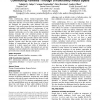Free Online Productivity Tools
i2Speak
i2Symbol
i2OCR
iTex2Img
iWeb2Print
iWeb2Shot
i2Type
iPdf2Split
iPdf2Merge
i2Bopomofo
i2Arabic
i2Style
i2Image
i2PDF
iLatex2Rtf
Sci2ools
CHI
2011
ACM
2011
ACM
Family portals: connecting families through a multifamily media space
Video conferencing allows distance-separated family members to interact somewhat akin to being together at the same place and time. Yet most video conferencing systems are designed for phone-like calls between only two locations. Using such systems for long interactions or social gatherings with multiple families is cumbersome, if not impossible. For this reason, we wanted to explore how families would make use of a video system that permitted sharing everyday life over extended periods of time between multiple locations. We designed a media space called Family Portals that provides shared video between three locations and deployed it within the homes of six families. Results show that the media space increased feelings of connectedness and the focus on a triad, in contrast to a dyad, caused new styles of interaction to emerge. Despite this, families experienced new privacy challenges and non-adoption by some family members, not previously seen in dyadic family media spaces. Author Ke...
CHI 2011 | Computer Supported Cooperative Work | Human Computer Interaction | Privacy Challenges | Video Conferencing Systems |
| Added | 25 Aug 2011 |
| Updated | 25 Aug 2011 |
| Type | Journal |
| Year | 2011 |
| Where | CHI |
| Authors | Tejinder K. Judge, Carman Neustaedter, Steve Harrison, Andrew C. Blose |
Comments (0)

